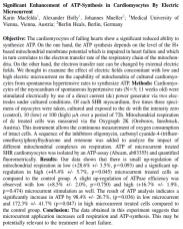Significant Enhancement of ATP Synthesis in Cardiomyocytes By Electric Microcurrent
Karin Macfelda1
, Alexander Holly1
, Johannes Mueller2
; 1
Medical University of
Vienna, Vienna, Austria; 2
Berlin Heals, Berlin, Germany
Objective: The cardiomyocytes of failing hearts show a significant reduced ability to
synthesize ATP. On the one hand, the ATP synthesis depends on the level of the H+
based mitochondrial membrane potential which is impaired in heart failure and which
in turn correlates to the electron transfer rate of the respiratory chain of the mitochondria. On the other hand, the electron transfer rate can be changed by external electric
fields. We thought to examine the effect of electric fields concomitant with low and
high electric microcurrent on the capability of mitochondria of cultured cardiomyocytes from spontaneous hypertensive rates to synthesize ATP. Methods: Cardiomyocytes of the myocardium of spontaneous hypertensive rats (N55; 11 weeks old) were
stimulated electrically by use of a direct current (dc) power generator via two electrodes under cultured conditions. Of each SHR myocardium, five times three specimens of myocytes were taken, cultured and exposed to the dc with the intensity zero
(control), 10 (low) or 100 (high) mA over a period of 72h. Mitochondrial respiration
of dc treated cells was measured via the Oxygraph 2K (Oroboros, Innsbruck,
Austria). This instrument allows the continuous measurement of oxygen consumption
of intact cells. A sequence of the inhibitors oligomycin, carbonyl cyanide-4-(trifluoromethoxy)phenylhydrazone and rotenone was added to analyze the impact of
different mitochondrial complexes on respiration. ATP of microcurrent treated
SHR cardiomyocytes was isolated by an ATP-assay (Abcam, ab83355) and quantified
fluorometrically. Results: Our data shows that there is small up-regulation of
mitochondrial respiration in low (+28.6% +/- 3.5%, p50.093) and a significant upregulation in high (+45.4% +/- 5.7%, p50.045) microcurrent treated cells as
compared to the control group. A slight up-regulation of ATPase efficiency was
observed with low (+8.5% +/- 2.0%, p50.750) and high (+16.7% +/- 1.9%,
p50.474) microcurrent stimulation as well. The result of ATP analysis indicates a
significantly increase in ATP by 98.4% +/- 26.7%, (p50.036) in low microcurrent
and 172.3% +/- 41.7% (p50.047) in high microcurrent treated cells compared to
the control group. Conclusion: The data obtained in this experiment suggests that
microcurrent application increases cell respiration and ATP-synthesis. This may be
potentially relevant to the treatment of heart failure.

